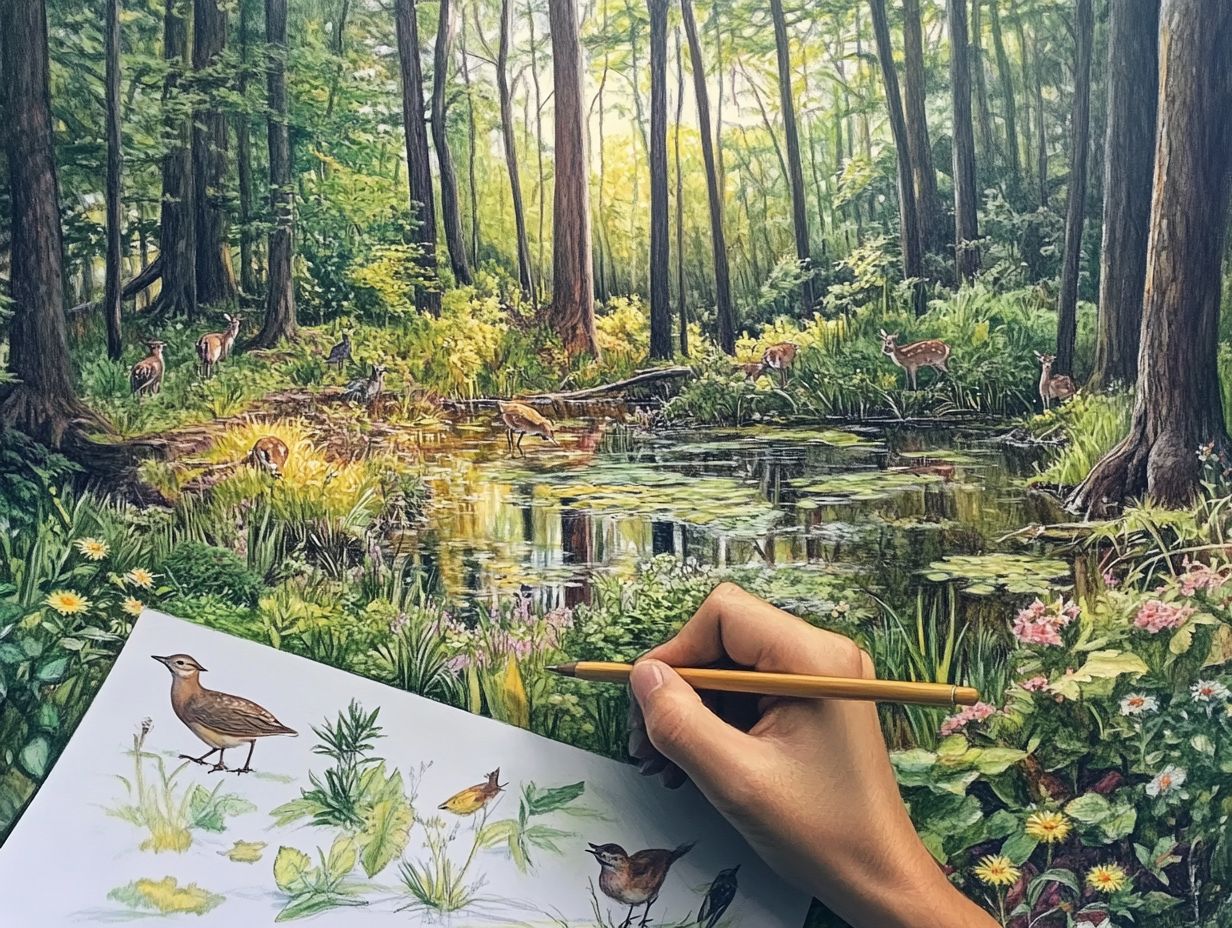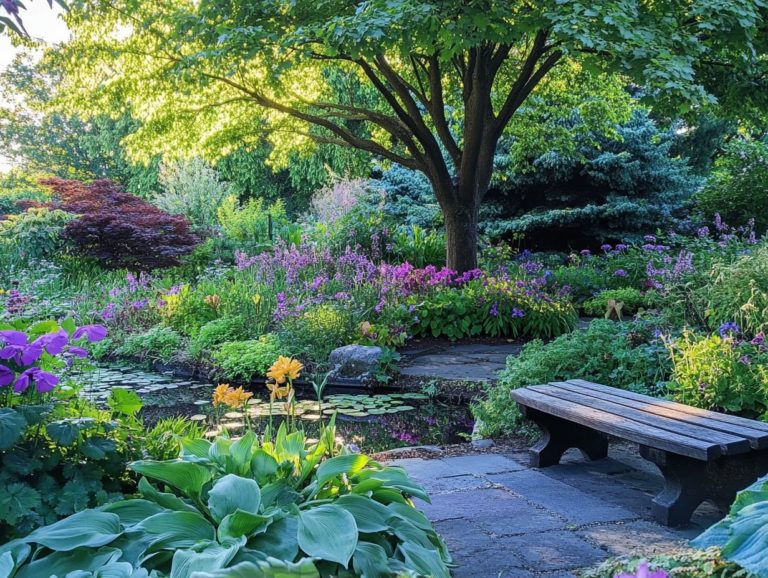How to Design for Wildlife Habitats
Designing for wildlife habitats and thoughtful garden design is essential for nurturing local ecosystems. As urbanization continues to encroach on natural spaces, it is crucial to integrate wildlife-friendly elements into your landscapes.
Let s explore the key factors you should consider, such as climate, location, native species, and biodiversity. You ll discover practical tips for crafting inviting outdoor spaces for birds, butterflies, and other wildlife. Plus, we ll cover conservation practices that ensure your wildlife habitat flourishes.
Start today to make a difference and foster a harmonious relationship between nature and your environment.
Contents
- Here s What You Need to Know!
- The Importance of Designing for Wildlife Habitats
- Factors to Consider when Designing for Wildlife Habitats
- Creating a Wildlife-Friendly Landscape
- Attracting Specific Types of Wildlife
- Maintaining and Monitoring the Habitat
- Frequently Asked Questions
- Why should we design wildlife habitats?
- What should I consider when designing a wildlife habitat?
- How can I attract a variety of wildlife to my backyard?
- What are some common mistakes to avoid when designing for wildlife habitats?
- Can I design a wildlife habitat in an urban area?
- How can I maintain a wildlife habitat in my backyard?
Here s What You Need to Know!

- Design wildlife habitats to boost the local ecosystem and promote biodiversity.
- Consider climate, location, and native species when designing a habitat. Use sustainable practices to maintain it.
- Attract specific types of wildlife by choosing appropriate plants and structures. Regularly maintain and monitor the habitat for long-term success.
The Importance of Designing for Wildlife Habitats
Designing wildlife habitats within urban communities is vital for enhancing biodiversity, helping nature work better, and supporting native wildlife. As urbanization increasingly encroaches upon natural ecosystems, integrating garden design with habitat creation becomes a key element in effective conservation efforts.
By thoughtfully considering landscape architecture and ecological functions, you can create outdoor spaces that resonate with aesthetic sensibilities while nurturing ecological balance, combating climate change, and ensuring the survival of diverse species. This approach fosters a thriving wildlife habitat right in your surroundings.
Benefits for Local Ecosystems
Creating wildlife habitats offers numerous benefits for local ecosystems. These habitats elevate biodiversity and provide essential ecosystem services that support both wildlife and human communities while promoting animal welfare.
Wildlife habitats play a pivotal role in improving water management by encouraging natural filtration processes that keep waterways clean. This ultimately benefits your local community and enhances urban areas. Research indicates that well-structured wildlife habitats can reduce stormwater runoff by as much as 30%, effectively mitigating erosion and flooding risks through sustainable materials.
By planting native flora and native trees within these habitats, you foster increased wildlife diversity, providing critical food and shelter for various species, including insects and pollinators. Recent data reveals that areas filled with native plants support up to 50% more wildlife than those dominated by non-native species.
Incorporating these native plants helps ecosystems flourish, enhancing soil health, carbon sequestration (the process of capturing and storing carbon dioxide to help fight climate change), and resilience to climate change. This contributes to the overall biodiversity and sustainability of landscapes.
Factors to Consider when Designing for Wildlife Habitats
When you design for wildlife habitats, it s essential to consider several critical factors. Think about the climate and location, as these elements play a pivotal role in the success of the habitat and its long-term biodiversity.
Selecting native species is crucial. It enhances biodiversity and creates a thriving environment for local wildlife.
Climate and Location
Understanding the climate and location is vital for creating a garden that attracts wildlife and supports local pollinators.
These factors determine which native plants will thrive in your garden.
Different climate zones, from arid deserts to lush temperate forests, dictate not only which plants can flourish but also how wildlife interacts with these environments.
For example, in more humid regions, you’ll find that moisture-loving plants draw in diverse insect populations, which, in turn, support the activity of birds and small mammals.
To assess local conditions, examine soil type, sunlight exposure, and moisture levels. This ensures your garden design integrates the necessary nutrients for plant health.
Such meticulous evaluations guide your selection of flora that best suits the area’s climate, fostering a welcoming environment where both plants and wildlife can coexist harmoniously.
Native Species and Biodiversity

Incorporating native species into your garden design is essential for promoting biodiversity.
These plants create effective wildlife habitats that attract a variety of pollinators and other native wildlife.
By selecting native plants that adapt to your local climate and soil conditions, you can reduce maintenance costs while ensuring healthier growth.
Native plants provide food and shelter for diverse species, from bees to butterflies.
For instance, plants like coneflowers and milkweed are vital food sources for pollinators, including monarch butterflies. This fosters a vibrant ecosystem.
These choices support the balance of nature, illustrating how thoughtful gardening practices enhance both the beauty of your garden and the ecological health of your surroundings.
Creating a Wildlife-Friendly Landscape
To create a wildlife-friendly landscape, embrace a thoughtful approach to garden design.
This includes incorporating elements such as bird feeders and hibernacula, which are places where animals can safely sleep or rest during cold months.
Utilize sustainable practices, select native plants, and integrate structures that foster native wildlife and enhance biodiversity.
Your efforts will create a vibrant ecosystem right in your backyard!
Choosing Plants and Structures
Choosing the right plants is essential let s make your garden a wildlife paradise!
The right plants and structures influence not only the ecological function but also the allure of your space for wildlife, including insects and birds.
Opting for native plants can significantly enhance your garden’s ability to support local fauna, providing essential food and habitat.
While non-native plants may catch your eye with their visual appeal, they often lack the same benefits and can disrupt local ecosystems.
Incorporating structures like birdhouses, bee hotels, and brush piles creates vital shelter and nesting sites.
These additions make your garden more welcoming for wildlife and contribute to a balanced ecosystem, promoting biodiversity in urban or suburban environments.
Implementing Sustainable Practices
Implementing sustainable practices in your garden design enhances wildlife habitats and bolsters the overall health of ecosystems through organic gardening methods like crop rotation and responsible resource management.
By incorporating water management techniques such as rainwater harvesting and installing drip irrigation systems, you can ensure your plants receive the moisture they need while minimizing waste. This helps protect local ecosystems.
Employing strategies to improve soil health, like crop rotation and composting, cultivates a robust ecosystem that nurtures beneficial microorganisms and reduces dependence on synthetic fertilizers.
Choosing sustainable materials for your garden structures, such as reclaimed wood or bamboo, can further reduce your environmental footprint while supporting conservation practices. These intentional methods promote biodiversity and create inviting habitats for various species, ultimately enriching your landscape and fostering a thriving natural balance.
Attracting Specific Types of Wildlife
Attracting particular species of wildlife, like birds and butterflies, requires a thoughtful approach to habitat design that includes pollinator plants. By carefully selecting and incorporating the right plants and features, you can create an environment that meets their specific needs and encourages their presence.
Birds, Butterflies, and Other Species

Creating a rich habitat for birds, butterflies, and other species involves understanding their unique needs and thoughtful features that invite them into your landscape, such as bird feeders and shallow water sources.
For example, birds benefit from varied food sources seeds, fruits, and insects paired with safe nesting sites like shrubs and trees that provide cover from predators. Similarly, butterflies thrive in spaces filled with nectar-rich flowers and host plants for their larvae.
To enhance these habitats, consider planting native flowering plants that bloom at different times throughout the season, ensuring a continuous food supply for pollinators and insects. Including shallow water sources, like birdbaths or small ponds, not only satisfies their thirst but also provides a delightful spot for bathing.
By embracing these strategies, you can cultivate a vibrant environment that nurtures the delicate balance of nature.
Maintaining and Monitoring the Habitat
Maintaining and monitoring wildlife habitats is vital for their success and fostering wildlife diversity. Regular assessments are key to keeping your habitat thriving!
By committing to these practices, you re preserving essential ecosystems and enhancing biodiversity for future generations, including initiatives led by organizations like the Florida Fish and Wildlife Conservation Commission.
Tips for Success
For your success in maintaining wildlife habitats, implementing effective maintenance strategies and fostering biodiversity through management adjustments is essential.
This journey involves understanding seasonal rhythms that influence habitat health and engaging local communities in proactive conservation efforts. Your seasonal maintenance routines might include:
- Monitoring water levels
- Clearing invasive species
- Planting native plants at the appropriate times of the year
Involving the community can significantly enhance your conservation initiatives, whether through organized clean-up events, educational workshops, or citizen science projects that promote public participation in habitat monitoring.
Utilizing technology or simple observational methods can help track biodiversity changes over time, allowing for timely adjustments to your conservation strategies and ensuring the resilience of these vital ecosystems.
Frequently Asked Questions
Why should we design wildlife habitats?
Designing for wildlife habitats is crucial because it creates sustainable environments where animals can thrive. It helps balance ecosystems and maintain biodiversity.
What should I consider when designing a wildlife habitat?

When designing a wildlife habitat, consider the specific needs of the animals you want to attract. Also, think about the local climate and ecosystem, as well as the availability of food, water, shelter, and breeding areas.
How can I attract a variety of wildlife to my backyard?
Attracting a variety of wildlife to your backyard is easy. Incorporate different types of plants, provide a water source, and offer diverse food options like fruits, nuts, and insects.
What are some common mistakes to avoid when designing for wildlife habitats?
Avoid common mistakes when designing wildlife habitats. Don’t use non-native plants, fail to provide enough shelter, or use harmful pesticides and herbicides.
Can I design a wildlife habitat in an urban area?
Designing a wildlife habitat in an urban area is possible. Use containers, rooftops, or small green spaces to create a welcoming environment for local wildlife.
How can I maintain a wildlife habitat in my backyard?
To maintain a healthy wildlife habitat, regularly care for plants and provide consistent food and water sources. Avoid using chemicals that could harm wildlife.
Don’t forget to let natural elements like leaf litter and fallen branches stay in your habitat. They offer crucial shelter and food for wildlife!






